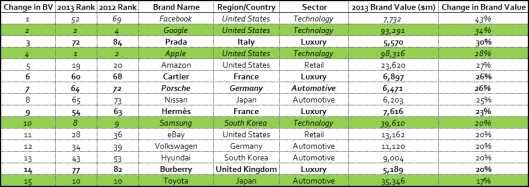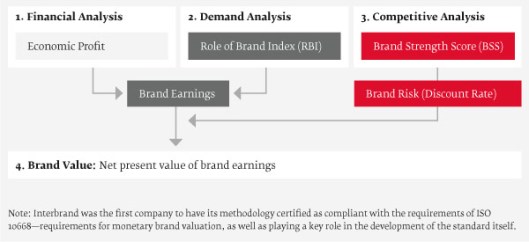Interbrand has just released its 14th Annual Best Global Brands report. This report is conducted via rigorous admissibility criteria for brands, and considers economic, demand and competition factors.
Naturally, when this model comes out every year, people and brands clamour to the top 10 list… The results are often interesting and not always expected. Interbrand does specify that due to their criteria, some brands you think might make the list don’t; like Walmart for example, who operates under different company names in different markets. See the top 100
What has particularly piqued my attention this year, is not the top 10 rank list, but rather the list of the top 10 brands whose brand value has changed the most.
 Source: Interbrand Best Global Brands 2013 – Interactive Table
Source: Interbrand Best Global Brands 2013 – Interactive Table
It’s interesting to see that four of the top movers are luxury brands – five if you include Porsche – which is slotted in the automotive category. In fact seven of the top 100 Global Best Brands are luxury brands; and you can make that ten if you include: Porsche, Ferrari and Moët & Chandon. As a note, four of these top ten movers are technology brands; twelve technology brands are on the top 100 list, and five of them in the top 5 overall. The combination of these facts is what I find interesting… I think they are telling about our so-called new consumers, whether those consumers are Millenials, Gen X, Boomers, etc. I think this gives us a glimpse that might transcend the generations.
____
In the past five years (give or take), consumers have experienced very tumultuous times. Borders being torn down and rebuilt. Economies: some crumbling, some hanging by a thread. Unemployment skyrocketing. If you are over 20, you’ve felt it. If you are under 20, you’ve heard it and though you may not fully understand it, it has affected you. On the one hand, when human beings get pushed into a corner, there is a sense of self-preservation that takes over. People default to a belief in scarcity and will fight tooth and nail to ensure they have a piece of the pie. On the other hand, those very same human beings come together in the belief that if they work together, each will have more than had they attempted to survive the challenges on their own.
In the past several years, we’ve seen people come together in newly-defined communities… Communities, which go beyond your residential address. Communities that connect over a shared value system, shared hopes, shared interests. To achieve this connectedness, technology is a must. So we can see how the quick rise and adoption of social channels to connect with these communities has bolstered the technology sector, financially yes, but also in terms of brand value. These new technologies have given the new communities a seamless platform, easy access to one another, a canvas where people can share.
We can see that some of the recent macro factors have certainly provided cause for the rise in brand standing of technology companies, but why are luxury brands faring well?
___
People are emotional creatures. Emotions are a person’s reaction to an event; are generated based on that person’s previous experiences and lens through which they see the world; and are manifested in multiple ways including internal physical reactions (i.e. increased heart rate) and external demonstrations (i.e. crying) – often both*. Based on the current state of the world, as mentioned earlier, a lot of people’s emotional reference points come from negativity: fear of instability, insecurity, loneliness, etc.
When people have some insecurities, whether they are expressed or not, they seek company for re-assurance, hence the rise of community. What’s important, however, is that the community is centred on common values, common interests, or common hopes. What’s important is that the community is centred around a shared story…
___
And this is where I think the luxury brands come into play. These luxury brands who’ve fared so well in Interbrand’s Best Global Brands have a story, they’ve been in existence for a century or more (except for Porsche – 72yrs; Ferrari – 66yrs; and Gucci – 92yrs). In that time, these brands have created such a story, such a legend. The brand is a common interest, a common hope and a common value. It is a legend to be shared.
These legends, these symbols offer hope and aspiration. They’ve evolved, pioneered style, revolutionized communities. When you see the brand, emotions are evoked. You discuss them with your communities – the good and the bad. They’ve become more accessible then they used to be; whether by design or by accident, their brand strength has increased by them coming out of the proverbial ivory towers. They remain luxury brands. Some of us will never be able to tangibly access them, but folks… perhaps the concept of aspiration is back.
___
Is your brand community-worthy? Are you offering a platform of positivity, shared values, shared interest and shared hope? Are you accessible? What do you offer? (Your product is not the only answer.)
* Please note: this is not a scientific definition of emotions; it is simply my paraphrased version based on numerous definitions available “out there”.


